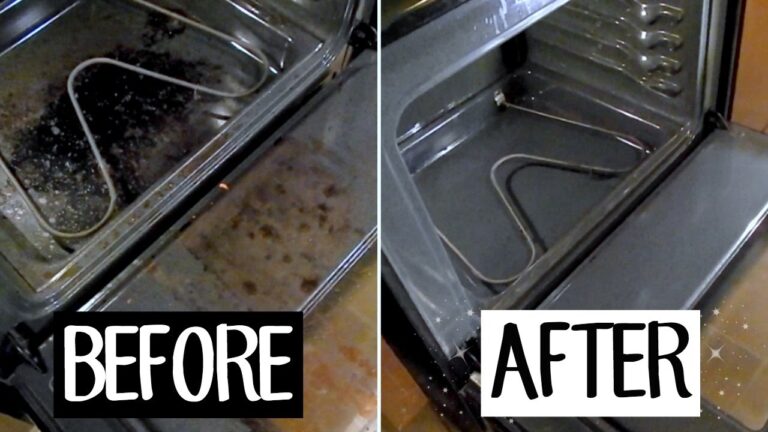Welcome to Curiosify, the hub of fascinating and mind-boggling curiosities! Today, we delve into the question: "Can you put plastic in the oven?" Join us as we uncover the surprising facts and debunk common misconceptions surrounding this intriguing topic. Get ready to ignite your curiosity and discover the truth behind this puzzling phenomenon.
- Why Can't You Put Plastic in the Oven? Unveiling the Curiosity
- HOW TO CLEAN YOUR OVEN WITH BAKING SODA & VINEGAR || BETHANY FONTAINE
- What type of plastic is safe to use in the oven?
- Will plastic melt at 170 degrees?
- Is it safe to put ready meal plastic in the oven?
- Why does plastic not melt in the oven?
- Preguntas Frecuentes
Why Can't You Put Plastic in the Oven? Unveiling the Curiosity
Plastic materials, although widely used in various applications, should never be put in the oven. The reason behind this lies in the nature of plastic and its response to heat. When exposed to high temperatures, plastic can melt, release toxic fumes, and potentially catch fire.
Plastic melting: Most commonly used plastics, such as polyethylene or polypropylene, have relatively low melting points. These temperatures are well within the range of a typical oven. When plastic reaches its melting point, it undergoes a physical transformation, losing its original form and becoming a molten liquid. This can lead to a messy cleanup and damage to the oven.
Release of toxic fumes: Heating plastic, especially beyond its melting point, can release harmful chemicals into the air. Different types of plastic contain various additives, including flame retardants, stabilizers, and pigments. When these additives are heated, they can decompose and release volatile organic compounds (VOCs) and other toxic fumes. Inhaling these fumes can pose health risks, especially in enclosed spaces like a kitchen.
Fire hazard: Certain types of plastic, such as polystyrene or PVC, are highly flammable. Exposing them to direct heat sources like an oven can potentially ignite the plastic, leading to a fire. This fire hazard is not worth the risk, as it can cause significant property damage and endanger lives.
To ensure safety in the kitchen, it is important to follow recommended guidelines for oven use. Stick to using oven-safe materials such as glass, ceramic, or metal cookware. If you are unsure about the oven-safety of a particular item, always refer to the manufacturer's instructions or consult reliable sources before attempting to use it in the oven.
Remember, keeping plastic away from direct heat sources, such as ovens, is essential to avoid potential hazards and maintain a safe cooking environment.
HOW TO CLEAN YOUR OVEN WITH BAKING SODA & VINEGAR || BETHANY FONTAINE
[arve url="https://www.youtube.com/embed/73OVlUSP_yM"/]
What type of plastic is safe to use in the oven?
When it comes to using plastic in the oven, it is important to choose a type of plastic that is safe for high temperatures.
One type of plastic that is generally considered safe for oven use is polypropylene (PP). This plastic has a high melting point and is resistant to heat, making it suitable for use in temperatures up to 250°F (121°C). It is commonly used in microwave-safe containers and some oven-safe cookware.
On the other hand, plastics such as polyethylene (PE), polystyrene (PS), and polyvinyl chloride (PVC) should not be used in the oven. These plastics have lower melting points and can release harmful chemicals when exposed to high temperatures, which can be dangerous for both your health and the quality of your food.
It is always recommended to check the manufacturer's instructions or packaging to ensure that the plastic product is labeled as oven-safe before using it in the oven. Additionally, using glass, ceramic, or stainless steel cookware is an alternative to safely cooking in the oven without the need for plastic.
Will plastic melt at 170 degrees?
Plastic generally starts to melt at temperatures above 170 degrees Celsius (338 degrees Fahrenheit). However, it is important to note that different types of plastic have varying melting points. For example, low-density polyethylene (LDPE) typically melts around 115-135 degrees Celsius (239-275 degrees Fahrenheit), while high-density polyethylene (HDPE) can withstand higher temperatures and generally melts around 130-135 degrees Celsius (266-275 degrees Fahrenheit).
It's crucial to exercise caution when working with plastic near its melting point, as exposure to high temperatures can release harmful fumes and potentially cause burns. Additionally, the chemical composition and additives in the plastic can affect its melting point. Therefore, it is always recommended to follow the manufacturer's guidelines and instructions when dealing with plastic materials.
Is it safe to put ready meal plastic in the oven?
No, it is not safe to put ready meal plastic packaging in the oven. Plastic packaging is not designed to withstand high temperatures and can release toxic chemicals when heated. It is important to always follow the instructions on the packaging and use the appropriate cookware for heating or cooking ready meals.
Why does plastic not melt in the oven?
Plastic does not melt in the oven because it has a higher melting point than the temperature typically reached by ovens. Most plastics have a melting point ranging from 160 to 280 degrees Celsius (320 to 536 degrees Fahrenheit), while ovens generally reach temperatures between 177 and 260 degrees Celsius (350 to 500 degrees Fahrenheit). This means that the heat produced by the oven is not enough to melt the plastic.
Additionally, plastic is composed of long polymer chains that are tightly bound together. These bonds give plastic its strong and durable properties, and they also make it more resistant to melting. As a result, plastic can withstand high temperatures without undergoing significant changes in its structure.
It is important to note that not all types of plastic are suitable for use in ovens. Some plastics can release harmful chemicals when exposed to high temperatures, so it is crucial to check the specific instructions or packaging of the plastic item before attempting to heat it in the oven.
Preguntas Frecuentes
Can you put plastic in the oven without melting it?
No, you should not put plastic in the oven as it will melt. Plastic is not designed to withstand high temperatures and can release toxic fumes when exposed to heat. It is important to use oven-safe materials such as glass, ceramic, or metal for cooking or reheating in the oven.
Is it safe to use plastic containers in the oven?
No, it is not safe to use plastic containers in the oven. Plastic containers are not designed to withstand high temperatures and can melt or release harmful chemicals when heated. It is important to use cookware that is specifically labeled as oven-safe for cooking in the oven. Options such as glass, ceramic, and oven-safe metal containers are recommended for oven use as they can handle the high temperatures without any risk of leaching chemicals or melting. Always check the instructions and labels on your cookware to ensure their suitability for oven use.
What happens if you accidentally bake plastic wrap in the oven?
If you accidentally bake plastic wrap in the oven, it can melt and release toxic fumes. Most plastic wraps are made of PVC (Polyvinyl Chloride), which has a low melting point. When exposed to high heat, PVC can release chemicals such as dioxins and phthalates, which can be harmful when inhaled or ingested. The melted plastic can also cause a mess in your oven and potentially damage it. Therefore, it is crucial to avoid placing plastic wrap in the oven and always use oven-safe containers or covers.
In conclusion, the topic of putting plastic in the oven is a curious one that sparks interest and raises questions about safety and practicality. Through our exploration, we have discovered that putting plastic in the oven is generally not recommended due to the potential risks of melting, releasing harmful fumes, and damaging both the plastic and the oven. While there may be certain heat-resistant plastics that can withstand oven temperatures, it is best to err on the side of caution and seek alternative options when it comes to cooking or heating. Remember, safety should always be a priority when experimenting with unusual and unconventional practices in the kitchen.
Si quieres conocer otros artículos parecidos a Can You Safely Put Plastic in the Oven? All Your Questions Answered puedes visitar la categoría Technology.

